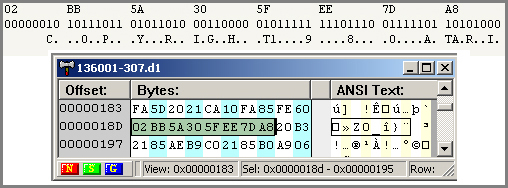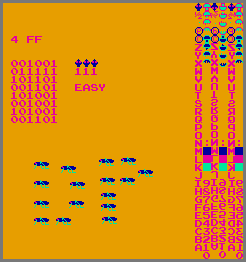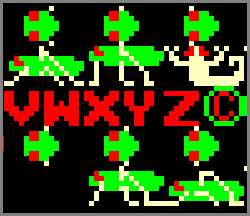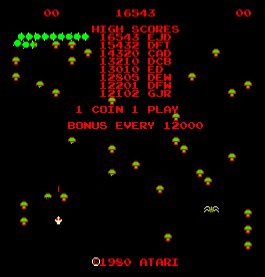

CENTIPEDE
• HIDDEN MESSAGE: As an anti-piracy protection method, a hidden message is buried within the code, written in Morse code. The code can be found in the ROM at location D1 on the board (picture #1). From Ed Logg: “As it was feared that companies or individuals would copy our game, but would deny that methods of electronic reproduction were used, Atari built in a ‘trap’ which is almost impossible to discover, and, in fact, was not discovered by the manufacturer of Magic Worm. This trap consists of a particular data pattern that has no function. It does not create any image on the screen or any sound. Only with the help of special “code” is it possible to read this pattern, and understand the message it contains. When you read the Centipede code with the “key” code, the secret message built into the game must be translated from International Morse Code. Such a translation of the code reads “COPYRIGHT 1980 ATARI”. This particular data pattern also appears in the Magic Worm program. Consequently, if one knows our special code, Magic Worm reproduces our secret message which is unique to Atari. This constitutes conclusive evidence that the manufacturer of this Magic Worm game (Sidam) copied substantial parts of our game by way of electronic reproduction. There is no secret key. If you use 0 for a dot and 1 for a dash and put this binary Morse code for "Copyright Atari 1980" into bytes. Then embed these bytes somewhere in the code. There were other things we did like check to make sure the copyright text or the game code was not changed. If I detected this the game would fail in different ways. All Atari games had some form of protection from blatant copying.” {Ed Logg}
• Hidden character - A grasshopper enemy was intended to be in the game, to keep the player from staying in one spot, but after Ed Logg realized the spider’s AI adequately covered the bottom area, the grasshopper wasn’t needed and was never coded in; only the animation graphics for it remain (picture #2). You can still see it by putting the game in test mode and cycling though all the different sprite graphics (picture #3).
• The initials for the design team are on the high score table (picture #4):
EJD - Erik Durfey (management)
DFT - Dave Theurer (support programmer)
CAD - Chris Downend (project leader)
DCB - Dona Bailey (co-designer)
ED - Ed Logg (designer and programmer)
DEW - Dave Webienson (technician)
DFW - Don Wrightnour (management)
GJR - Greg Rivera (support programmer)
• The board has output for B&W, although it was never released with a B&W monitor.
• Both Centipede and Millipede support the use of both a joystick and a trackball. Centipede was originally designed for use with a joystick; trackball support was added later. Mike Mika states the input did not change - it still just checks to see if you are moving left/right/up/down. It totally feels like trackball control, but it’s not. It adds acceleration to the player in software. From Ed Logg: “The game idea for Centipede originally did specify a joystick but it’s almost impossible to play well with one. There is no way to get speed from a joystick. Nor is there a way to get more than 8 directions from a joystick. I do not remember why there is joystick code there. Perhaps Marketing asked for it at some point.”
• On levels having complete Centipedes, fleas will never appear.
• From 0 - 300,000, the speed of the centipede heads increases from the side feed, and the spider will change behavior.
• Spiders: From 0-100,000, the spiders are passive, and only comes out from a few angles. From 100,000-200,000, they become more aggressive, and target your shooter and side mushrooms. From 200,000-300,000, they become super-agressive, and stay much lower, and targets you almost instantly. This cycle repeats 2 more times for 300,000-600,000, and again from 600,000-900,000. From 900,000-996,000, the spider is very passive again.
• To trap the centipede, allow the centipede to come near the bottom of the screen. When it is close to the left or right side, shoot the centipede once, causing a mushroom to appear and the centipede to come back under and near the mushroom. Now, shoot and make another mushroom. Repeat this process until you have a row of mushrooms almost vertically lined up near the bottom of the screen. Then, by either dying or just allowing the centipede to work his way back up, the centipede will be trapped between the edge of the screen and the mushrooms allowing you to shoot everything else.
• Cabaret (mini) cabinets and cocktail units were released with 19-inch monitors and there were also a limited number cocktails built with only 13-inch monitors.
• Several different versions of the side art were made; with either yellow, pink, blue, or purple outlines.
• See this SITE for different playing strategies (tunnel, blob, safety zone, and trap).
• BUG: When you reach 996,000 points, the counter that the machine keeps for when to give you the next free man starts immediately at 996K regardless of how many men you have built up. The next free man would be at 1,008,000, but the counter overflows and checks to see if you are over 8,000. After that free man, it will check if you are over 20,000, and so on. It will check once any time points are scored. So, if you hit six things to pass 1M, your next free man would be at 68K. The score turns over to 0, and the game continues. It can be repeated indefinitely.
• BUG: On cocktail table models, there’s a glitch in the spider’s AI for player #2 – instead of the spider’s area shrinking, it actually expands, making the spider easier to hunt, but it also negates the ‘blob’ mushroom strategy. {Ed Logg}
• BUG: Occasionally, the second screen (blue millipede) plays twice. Normally it should go: screen 1, screen 2, bee wave, screen 3. But sometimes it goes: screen 1, screen 2, screen 2, bee wave, screen 3. {Dave Giarusso}



